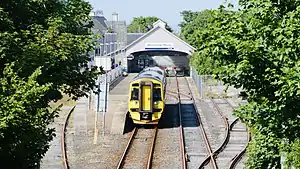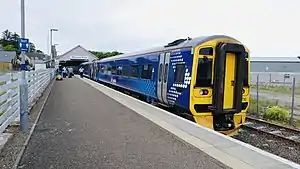 | |
| General information | |
| Location | Thurso, Highland Scotland |
| Coordinates | 58°35′24″N 3°31′40″W / 58.5900°N 3.5278°W |
| Grid reference | ND112679 |
| Managed by | ScotRail |
| Platforms | 1 |
| Other information | |
| Station code | THS[2] |
| History | |
| Original company | Sutherland and Caithness Railway |
| Pre-grouping | Highland Railway |
| Post-grouping | LMS |
| Key dates | |
| 28 July 1874 | Opened |
| Passengers | |
| 2018/19 | |
| 2019/20 | |
| 2020/21 | |
| 2021/22 | |
| 2022/23 | |
Listed Building – Category B | |
| Designated | 28 November 1984 (amended 15 December 1998) |
| Reference no. | Historic Scotland Building ID 42035 |
| Notes | |
Passenger statistics from the Office of Rail and Road | |
Thurso railway station is a railway station located in Thurso, in the Highland council area in the far north of Scotland. It serves the town of Thurso and its surrounding areas in the historic county of Caithness. It is also the nearest station to the port of Scrabster (about 2.2 miles (3.5 km) to the northwest), which has ferry services linking the mainland with Stromness on the Orkney Islands. It is the northernmost station on the National Rail network.[3]
The station is situated at the end of a short branch line off the Far North Line. It is 6 miles 50 chains (10.7 km) down the line from Georgemas Junction (the other end of the branch), and 153 miles 70 chains (247.6 km) from Inverness.[4]
Thurso station is managed by ScotRail, which also operates all trains serving the station.
History
The station opened on 28 July 1874.[5] A wrought-iron turntable, 45 feet (14 m) in diameter, was built at the station by the Railway Steel and Plant Company of Manchester.[6]
The station was threatened with closure in the 1960s under the Beeching Axe.
Until 2000, trains from Inverness would split in half at Georgemas Junction, with one portion going to Wick and the other to Thurso. In the age of locomotive-hauled trains prior to the introduction of diesel multiple units by British Rail, a locomotive was based at Georgemas Junction to take the Thurso portion to and from the junction. The practice of splitting trains ended when Class 158s were introduced on the line – since then all services run in full between Inverness and Wick via Thurso, in both directions, meaning they call at Georgemas Junction twice.[7]
Facilities
There is one platform, which is long enough to accommodate a nine-carriage train.[8] The station is fully wheelchair-accessible, but it is not monitored by CCTV.[9] The station has a ticket office, although there are no self-service ticket machines , except for some smartcard validators. Other facilities include: a small car park, a sheltered bike stand, a payphone, waiting rooms, toilets and a post box.[9]
There is a bus stop located directly outside the station,[9] although the majority of bus services call at the nearby Miller Academy stop, 150 metres (160 yd) to the north.
Services

Despite being located at the end of the branch line, Thurso is not the terminus for any passenger services. On weekdays and Saturdays, the station is served by eight trains per day to Georgemas Junction, of which four continue to Inverness (via Helmsdale, Golspie, Lairg, Tain and Dingwall), and four continue to Wick. On Sundays the frequency drops to just two trains per day to Georgemas Junction, of which one goes to Inverness and one to Wick.[7]
An hourly shuttle between Wick and Thurso making use of Vivarail's Class 230 Battery Multiple Units was proposed by the Friends of the Far North line.[10]
| Preceding station | Following station | |||
|---|---|---|---|---|
| Georgemas Junction | ScotRail Far North Line |
Georgemas Junction | ||
| Historical railways | ||||
| Terminus | Highland Railway Sutherland and Caithness Railway Thurso Branch |
Hoy Line open, station closed | ||
References
- ↑ Brailsford 2017, Gaelic/English Station Index.
- ↑ Deaves, Phil. "Railway Codes". railwaycodes.org.uk. Retrieved 27 September 2022.
- ↑ Pipe, Vicki; Marshall, Geoff (2018). The Railway Adventures. September Publishing.
- ↑ Bridge, Mike, ed. (2017). TRACKatlas of Mainland Britain: A Comprehensive Geographic Atlas Showing the Rail Network of Great Britain (3rd ed.). Sheffield: Platform 5 Publishing Ltd. p. 104. ISBN 978 1909431 26 3.
- ↑ "The Sunderland and Caithness Railway". The Scotsman. British Newspaper Archive. 27 July 1874. Retrieved 14 August 2016 – via British Newspaper Archive.
- ↑ "The Sutherland and Caithness Railway". John o’Groat Journal. Scotland. 9 July 1874. Retrieved 15 July 2017 – via British Newspaper Archive.
- 1 2 eNRT December 2021 Edition, Table 219
- ↑ Brailsford 2017, map 20E.
- 1 2 3 "Facilities". ScotRail. ScotRail. Retrieved 25 January 2020.
- ↑ "The Friends of the Far North Line - Newsletter - January 2019". www.fofnl.org.uk. Retrieved 22 April 2020.
Bibliography
- Brailsford, Martyn, ed. (December 2017) [1987]. Railway Track Diagrams 1: Scotland & Isle of Man (6th ed.). Frome: Trackmaps. ISBN 978-0-9549866-9-8.
- Butt, R. V. J. (October 1995). The Directory of Railway Stations: details every public and private passenger station, halt, platform and stopping place, past and present (1st ed.). Sparkford: Patrick Stephens Ltd. ISBN 978-1-85260-508-7. OCLC 60251199. OL 11956311M.
- Jowett, Alan (March 1989). Jowett's Railway Atlas of Great Britain and Ireland: From Pre-Grouping to the Present Day (1st ed.). Sparkford: Patrick Stephens Ltd. ISBN 978-1-85260-086-0. OCLC 22311137.
External links
- Train times and station information for Thurso railway station from National Rail
- RAILSCOT article on Sutherland and Caithness Railway
- RAILSCOT page on Thurso